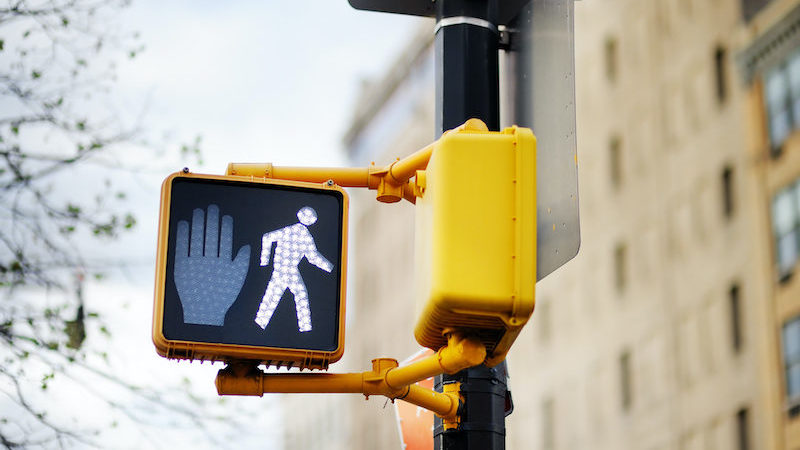
The United States has failed to realize the ADA’s potential to impact the rights of people with disabilities.
A federal judge for the Southern District of New York recently ruled that the city of New York violated the Americans with Disabilities Act (ADA) by failing to install audible devices at crosswalks. These devices tell blind and visually impaired people when it is safe to cross the streets, but the city had installed them in only 3.4 percent of intersections. The federal district court concluded that the city’s conduct amounted to an illegal denial of services and benefits by a public entity in violation of Title II of the ADA.
The decision comes 30 years after the U.S. Congress enacted the ADA. If the court’s interpretation of the ADA is sound, then New York City, and likely cities across the country, have been allowed to flout the ADA for more than three decades, with courts just now enforcing its requirements.
What took so long?
Compliance with the ADA’s accessibility requirements can never be taken for granted. The implementation of measures to ensure compliance with accessibility rules has been subpar, and examples of inaccessible spaces—both of state and local government and privately owned—abound. The enforcement of the ADA’s accessibility mandates has been left to individual litigants, typically after construction has been completed—a mechanism often portrayed in media as fraudulent and abusive “drive-by litigation.”
But more broadly, the meaning of the ADA, and the extent to which it guarantees equality for people with disabilities, have been subject to political and legal struggle almost from its inception. Continuing disputes over who deserves to be protected by the ADA and what it requires have resulted in a host of U.S. Supreme Court decisions, hundreds of pages of federal regulations, one major congressional revision, and a stream of lawsuits similar to the recent one from New York City.
This struggle over the meaning of the ADA might seem surprising in light of the law’s origins. The enactment of the ADA was surprisingly bipartisan, especially from the perspective of 2020.
The ADA is the product of decades of activism by people—some of them quite radical in political orientation—with many different impairments, who came together to form the disability rights movement. The ADA itself, though, was nurtured in a commission created by President Ronald Reagan, passed overwhelmingly in Congress, and signed into law with the strong support of President George H.W. Bush. Beneath the surface, however, there was much conflict over how far the law should sweep and how much it should require of the entities it regulated. Resolving these conflicts required compromises that limited enforcement efforts and provided qualified defenses for regulated entities. As a result, courts have largely been left to wrestle over the meaning of key phrases such as “reasonable accommodation,” “undue hardship,” and “readily accessible.”
Congress borrowed much of the language of the ADA from regulations based on an earlier law, Section 504 of the 1973 Rehabilitation Act, that had been kicking around federal courts for years. The drafters of the ADA thought that the meaning of the Rehabilitation Act’s central provisions had been thoroughly settled by Section 504 litigation, and that using the same language in the ADA would therefore prove uncontroversial. But the judiciary’s reaction to the ADA was not what its drafters anticipated.
Many federal court decisions in the first two decades of the ADA were hostile to disability rights, with defendants prevailing in the vast majority of the cases in district and appellate courts. Most dramatically, in a series of cases dealing with employment discrimination known as the Sutton trilogy, the Supreme Court in 1999 interpreted the law’s definition of disability narrowly and, in so doing, curtailed discrimination lawsuits before would-be plaintiffs had the chance to make their case.
Congress reacted to the Sutton trilogy and other restrictive court decisions by enacting the ADA Amendments Act of 2008. Congress meant for this legislation to refocus ADA litigation on issues of discrimination, as opposed to plaintiffs’ standing. Studies suggest courts have largely followed this directive.
Although the ADA was promoted as protecting the civil rights of people with disabilities, it was also framed as welfare reform. Sponsoring U.S. Senator Tom Harkin claimed that the law would “strengthen our economy and enhance our international competitiveness” by bringing people with disabilities into the labor force and off government support. In the years since the ADA’s enactment, however, the gap in employment between people with disabilities and non-disabled people has grown. Early research suggested that the ADA had the perverse effect of reducing employment among people with disabilities. More recent studies conclude that the ADA has had a modestly positive impact on hiring, but that discrimination continues to be a serious problem.
Beyond the United States, the ADA and the disability rights movement went “on the road” to inspire activists and legislatures throughout the world. This movement culminated in the United Nations’s Convention on the Rights of Persons with Disabilities, which draws concepts and language from the ADA. The Convention has been ratified by more than 170 countries, but the United States is not among them. Ratification fell six votes short in the U.S. Senate, an indication mainly of Republican opposition to United Nations treaties—and, perhaps, opposition to the continued political struggle for disability rights in the United States.
Nearly every day adds a new chapter to the story of this struggle. On the day after the decision on audible traffic devices in New York City, the Supreme Court ruled on another case involving the rights of people with disabilities on streets and sidewalks, siding with Alabama state officials who stopped an effort to allow people with disabilities to avoid the risks associated with COVID-19 and vote safely from their cars by handing their ballots to election officials.
Curbside voting seemed a perfect example of “reasonable accommodation,” a core concept in the ADA, yet the Court overturned the decisions of two lower federal courts without explanation, allowing Alabama to ban curbside voting. Dissenting with two other justices, Justice Sonia Sotomayor urged the Court not to stand in the way of local election officials who were willing to help vulnerable voters fulfill their civic duty.
The Court’s ruling was an unfortunate note in a campaign during which, at least on the Democratic side, disability rights policy was prominently discussed, with all major candidates, including President-Elect Joe Biden, presenting plans to realize the promise of the ADA made three decades ago. With the COVID-19 pandemic continuing to ravage the United States—posing particular challenges for some people with disabilities—the Biden Administration will take center stage as the struggle over the ADA reaches its fourth decade.
This essay is part of a series entitled Thirty Years of the Americans With Disabilities Act.





